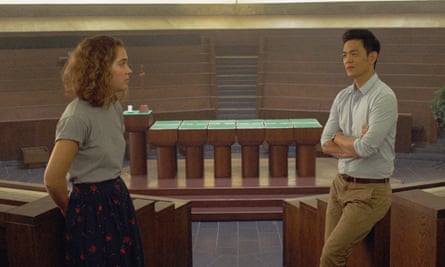Kogonada – the name is a pseudonym – is a South Korean writer-director. His debut feature, Columbus, is set in the Indiana town of the same name, known for its unusual wealth of modernist architecture by major names such as IM Pei and Robert Venturi. The film stars John Cho – recently in thriller Searching – alongside the up-and-coming Haley Lu Richardson, who plays a teenager fascinated by her home town’s buildings. Kogonada is also famous for his video essays on film-makers including Stanley Kubrick, Yasujiro Ozu and Richard Linklater.
Apparently you discovered Columbus from a New York Times article, and were moved to go and explore.
I grew up in the midwest and I’d taken the highway past Columbus. There’s nothing to indicate that it’s anything but another town, it’s just cornfields and cornfields. Then I read this article about it being a mecca of modernism and I was fascinated. So I went there, and I was immediately struck by it. I told my wife by lunchtime: “I have to film something here.”
What buildings most excited you on that first visit?
There were some buildings that I looked at and I wasn’t immediately taken by, but the next day they lingered with me. Like City Hall – it has these cantilevered beams that don’t connect, with this space between them. The Saarinen buildings are irresistible – I liked the conversation between the two churches built by the father Eliel and the son Eero.
Haley Lu Richardson is superb in what is an unusual role in contemporary US cinema – a teenager embarking on an intellectual and aesthetic adventure…
Yes, and from the midwest, the flyover zone of America. Those people have been really caricatured in a lot of movies as lacking curiosity. Haley Lu is quite brilliant. I wanted Casey to be someone you didn’t recognise – I love discovery in movies when you don’t know an actor, and they’re being revealed before you.

John Cho, best known for the Star Trek and Harold & Kumar movies, is moving into more substantial roles. He’s been the subject of a hashtag campaign, #StarringJohnCho, about making Asian actors more visible in Hollywood.
It was just: “Can you imagine someone like John Cho being in all these mainstream films?” And everyone was like: “Oh yeah.” Some financiers said to us: “You want an Asian-American male lead? There’s no interest in that.” Now you have Crazy Rich Asians and Searching. People used to say that about movies featuring African Americans, that the audience would be exclusively African American. They’re just myths that are being challenged.
How did you start making your video essays about film-makers and their styles? It must take quite an obsessive mindset.
Part of it was desperation to create something out of the material of this form that I loved. At the time I was doing a film studies PhD, but trying to express things in the academic idiom was really a struggle. When I allowed myself to re-enter the world of images, like in editing, that came a lot easier to me. I am sort of obsessive. I was raised to pay attention to forms; I’d have conversations with my father about the form of things. He would have me look at rocks and branches a certain way.
Apparently you have two new projects in the works. How are they going?
There’s one I’ve written that’s a little smaller-scale. The other [Saying Goodbye to Yang] is an adaptation of a sci-fi short story. It’s very much in my wheelhouse because it’s a family drama. I’m not necessarily into the sci-fi genre, but any time I see a really compelling sci-fi world, I always wonder what daily life is like in it.
How do the people of Columbus feel about their town being the birthplace of Mike Pence, the US vice-president?
People I’ve engaged with are all on the progressive liberal side of things, so they just shake their heads. That’s the interesting thing: Columbus was a kind of experiment by an organisation called the Cummins Foundation, in the belief that buildings can shape our sensibilities. Its head, Irwin Miller, was very progressive and wanted to foster that – but then you have Mike Pence coming out of that environment. So it says something about the limitations of art.

Comments (…)
Sign in or create your Guardian account to join the discussion